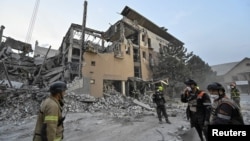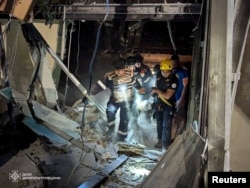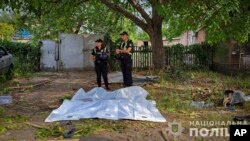Ukraine’s army chief claimed Tuesday that Kyiv’s forces have gained control of nearly 1,300 square kilometers (500 square miles) of Russia’s Kursk region during its three-week incursion and captured 594 Russian prisoners it hopes to use in an exchange for Ukrainians held by Russia.
General Oleksandr Syrskyi said the Ukrainian advance was drawing Russian troops from elsewhere, with Moscow attempting “to create a ring of defense around our offensive group of troops and plan counteroffensive actions.”
Syrskyi’s assessment of the Ukrainian advance came as Ukrainian President Volodymyr Zelenskyy said Russia targeted Ukraine overnight with 81 more drone attacks, along with cruise and ballistic missiles, the day after launching about 200 aerial assaults aimed chiefly at Ukrainian power plants and other infrastructure.
Five people were reported killed and 16 injured in the new attacks.
Zelenskyy wrote on the X media platform, "We will undoubtedly respond to Russia for this and all other attacks. Crimes against humanity cannot go unpunished."
The Kursk operation, the largest incursion into Russia since World War II, has forced about 130,000 residents to evacuate their homes. Russia has sent reinforcements into the region, but it was not clear to what extent these movements might be weakening Russia's positions in eastern Ukraine, where Moscow’s forces have been gaining ground.
Zelenskyy said Tuesday that Russia is not relocating troops to Kursk from Donetsk, the eastern Ukraine region that is the center of the war and where Russia has been making slow advances. However, Zelenskyy said the Kursk operation had prevented Russia's aims of taking territory in the Sumy and Kharkiv regions to the west of Kursk.
The Russian Defense Ministry said Tuesday that Ukraine has suffered heavy casualties in Kursk — about 6,600 troops either killed or injured — and that more than 70 tanks have been destroyed, along with scores of armored vehicles. Those figures could not be independently confirmed.
Vulnerable energy infrastructure
In the Kyiv region, which struggled with blackouts after Monday's onslaught against energy facilities throughout the country, five air alerts were called during the night. The regional administration said that air defenses destroyed all the drones and missiles but that falling debris set off forest fires.
After Monday's barrage across Ukraine of more than 100 missiles and a similar number of drones, Ukrainian Prime Minister Denys Shmyhal said, "The energy infrastructure has once again become the target of Russian terrorists." He urged Ukraine's allies to provide it with long-range weapons and permission to use them on targets inside Russia.
In the new attack, Ukraine’s air force said the country’s air defenses shot down five of the missiles and 60 of the drones, while 10 more drones likely crashed in Ukrainian territory.
The intercepts took place all over Ukraine, including in the Cherkasy, Chernihiv, Dnipropetrovsk, Kharkiv, Kherson, Khmelnytskyi, Kirovohrad, Kyiv, Mykolaiv, Poltava, Rivne, Sumy, Vinnytsia, Zaporizhzhia and Zhytomyr regions.
The governor of Kharkiv reported a missile strike on an infrastructure facility that injured four people. The governor of Khmelnytskyi said one person was hurt in the attacks, which also caused fires at two houses.
Ukrainian strikes in Russia
Russia’s Defense Ministry said Tuesday it shot down three Ukrainian drones over its Belgorod region and two drones over the Kursk region.
Zelenskyy reiterated his calls for more long-range attack capabilities for his forces, saying that is necessary to target the areas in Russian border regions that Russian forces are using to launch missiles and drones at Ukraine.
“This is the optimal anti-terrorist tactic that every one of our [Western] partners, from whom we expect decisions regarding our long-range capabilities, would rightfully employ and certainly use to protect themselves,” Zelenskyy said late Monday.
Russia's Defense Ministry said Monday its forces used high-precision weapons to strike important energy infrastructure in Ukraine that it said supported the military-industrial complex. It listed power substations, gas compressor stations and storage sites for aircraft weapons.
Some information for this story was provided by The Associated Press, Agence France-Presse and Reuters.











